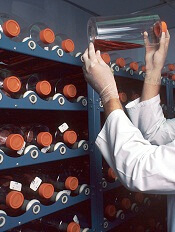
Photo by Linda Bartlett
ORLANDO—Emicizumab, a bispecific monoclonal antibody (mAb), could potentially change the treatment paradigm of hemophilia A, according to a speaker at the World Federation of Hemophilia 2016 World Congress.
Results of a phase 1/2 study suggest that emicizumab can be safe and effective as once-weekly prophylaxis in patients with severe hemophilia A, whether or not they have factor VIII (FVIII) inhibitors.
There were no severe adverse events (AEs) or thromboembolic events associated with the mAb.
None of the patients developed neutralizing anti-drug antibodies, and the annualized bleeding rate (ABR) was low, with 8 of the 18 patients studied having no bleeds.
Keiji Nogami, MD, PhD, of Nara Medical University in Kashihara, Japan, presented these results at the congress.* This research was sponsored by Chugai Pharmaceutical Co., Ltd., which is co-developing emicizumab with Genentech.
The phase 1 part of this study included both healthy subjects and hemophilia A patients. Results in the healthy subjects were published in Blood, and early results in the patients were published in NEJM.
Patients and treatment
The 18 patients in this study had severe hemophilia A, and 11 had FVIII inhibitors. They were 12 to 58 years of age at baseline, and all were Japanese.
The patients received once-weekly subcutaneous injections of emicizumab at one of the following dose levels: 0.3 mg/kg (cohort 1), 1 mg/kg (cohort 2), or 3 mg/kg (cohort 3).
There were 6 patients in each cohort. Cohorts 1 and 2 each had 4 patients with inhibitors, and there were 3 patients with inhibitors in cohort 3.
For the phase 2 extension portion of the study, dose-escalation was allowed in cohorts 1 and 2. A total of 4 patients had their doses increased because of suboptimal bleeding control—3 in cohort 1 and 1 in cohort 2.
The mean follow-up was 32.6 months in cohort 1, 27.0 months in cohort 2, and 21.4 months in cohort 3.
One of the patients with inhibitors in cohort 2 discontinued emicizumab due to injection site erythema of mild intensity during the phase 1 portion of the study. And one of the patients without inhibitors in cohort 3 did not continue on to the phase 2 portion of the study because prior treatment was sufficiently effective.
Safety
The safety analysis included all 18 patients, and all of these patients experienced AEs—a total of 150 events. The most common AEs were nasopharyngitis (n=8), contusion (n=7), and injection site reactions (n=7).
The AEs were largely of mild or moderate intensity. There were 4 severe AEs, but none of them were related to emicizumab.
There were 14 treatment-related AEs in 7 patients, but all were resolved. There were no thromboembolic AEs or clinically significant abnormalities of coagulation tests.
There were no neutralizing anti-drug antibodies. Three patients developed anti-drug antibodies after starting emicizumab, but this did not affect the pharmacokinetics, pharmacodynamics, safety, or efficacy of the mAb.
Efficacy
In cohort 1, the median ABR was 32.5 at baseline, 4.4 at 12 weeks, and 1.4 at last follow-up (median of 32.6 months).
In cohort 2, the median ABR was 18.3 at baseline, 0.0 at 12 weeks, and 0.2 at last follow-up (median of 27.0 months).
In cohort 3, the median ABR was 15.2 at baseline, 0.0 at 12 weeks, and 0.0 at last follow-up (median of 21.4 months).
Eight patients did not experience any bleeds—1 inhibitor patient in cohort 1, 3 inhibitor patients in cohort 2, 2 inhibitor patients in cohort 3, and 2 non-inhibitor patients in cohort 3.
Breakthrough bleeds were successfully treated with standard episodic treatment, FVIII products, or bypassing agents.
Based on these results, Dr Nogami said emicizumab prophylaxis has the potential to change the treatment paradigm of hemophilia A, irrespective of inhibitor status.


